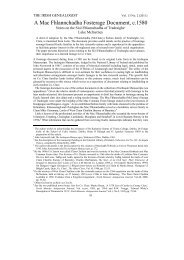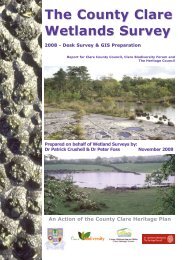Documents from the Thomond Papers at Petworth House Archive1 ...
Documents from the Thomond Papers at Petworth House Archive1 ...
Documents from the Thomond Papers at Petworth House Archive1 ...
You also want an ePaper? Increase the reach of your titles
YUMPU automatically turns print PDFs into web optimized ePapers that Google loves.
Archivium Hibernicum<br />
seals. The manuscripts are available for public consult<strong>at</strong>ion only <strong>at</strong> <strong>the</strong><br />
West Sussex Record Office in Chichester. 4<br />
This article pays particular <strong>at</strong>tention to four documents <strong>from</strong> <strong>the</strong><br />
<strong>Thomond</strong> papers <strong>at</strong> <strong>Petworth</strong> <strong>House</strong> Archive. As will be seen, <strong>the</strong>y demonstr<strong>at</strong>e<br />
<strong>the</strong> utility of <strong>the</strong> collection in understanding <strong>the</strong> critical juncture of<br />
1581–1624 when <strong>the</strong> earldom of <strong>Thomond</strong> was held by Donough O’Brien,<br />
fourth earl. Donough, a loyalist and a principal architect of <strong>the</strong> transform<strong>at</strong>ion<br />
of <strong>Thomond</strong> <strong>from</strong> a Gaelic feudal polity to a shired county, was<br />
a scion of <strong>the</strong> ruling O’Brien (Uí Bhriain) dynasty which had renounced<br />
its claim to kinship under Henry VIII’s so-called ‘Surrender and Regrant’<br />
scheme in 1543. The anglicis<strong>at</strong>ion process in <strong>Thomond</strong> has been explained<br />
primarily by exogenous factors such as <strong>the</strong> incorpor<strong>at</strong>ion of market towns<br />
and settlement of English and Dutch planters. 5 The value of <strong>the</strong> <strong>Thomond</strong><br />
<strong>Papers</strong> <strong>at</strong> <strong>Petworth</strong> is th<strong>at</strong> <strong>the</strong> transition process which acceler<strong>at</strong>ed after<br />
<strong>the</strong> de<strong>at</strong>h of Connor O’Brien, third earl in 1581, can be elucid<strong>at</strong>ed by rare<br />
document<strong>at</strong>ion issuing <strong>from</strong> both sidelined Gaelic septs and <strong>the</strong> small<br />
clique of Gaelic magn<strong>at</strong>es who adjusted to <strong>the</strong> new political realities. 6<br />
The corpus of m<strong>at</strong>erial th<strong>at</strong> rel<strong>at</strong>es to <strong>the</strong> lesser Gaelic families of<br />
<strong>Thomond</strong> is particularly deserving of public<strong>at</strong>ion, not least on account<br />
of <strong>the</strong> social and economic inform<strong>at</strong>ion it contains. For example, <strong>the</strong><br />
presence of specialist learned families such as <strong>the</strong> Uí Mhaoilchonaire,<br />
Mhic Bhruaideadha and Mhic Fhlannchadha is documented in various<br />
legal papers where <strong>the</strong>y appear as witnesses and local officials of <strong>the</strong> earl<br />
of <strong>Thomond</strong>. <strong>Documents</strong> with unique references to landholding arrangements,<br />
kinship ties and local authority are reproduced here in full.<br />
Excerpted references <strong>from</strong> various documents are also presented.<br />
<strong>Thomond</strong> <strong>Papers</strong> <strong>at</strong> <strong>Petworth</strong><br />
The <strong>Thomond</strong> papers deposited in <strong>the</strong> <strong>Petworth</strong> Archive origin<strong>at</strong>e <strong>from</strong> <strong>the</strong><br />
senior lineage of <strong>the</strong> O’Brien family (who claimed descent <strong>from</strong> high king<br />
4 <strong>Documents</strong> in <strong>the</strong> <strong>Petworth</strong> Archive are available only by prior arrangement (two weeks in<br />
advance) with <strong>the</strong> archivist <strong>at</strong> <strong>the</strong> West Sussex Record Office in Chichester. Lord Egremont’s<br />
permission is needed for public<strong>at</strong>ion of all PHA documents<br />
5 See, for example, Bernadette Cunningham, ‘Newcomers in <strong>the</strong> <strong>Thomond</strong> Lordship, c.1580c.1625’<br />
in Dal gCais, xi (1993), pp 103–111. In 1606 <strong>the</strong> earl of <strong>Thomond</strong> was commended by<br />
English officials for entertaining and receiving ‘as many English as he can any way draw<br />
unto him, and uses <strong>the</strong>m so well th<strong>at</strong> many resort thi<strong>the</strong>r’. Rev. C.W. Russell (ed.) Calendar<br />
of <strong>the</strong> St<strong>at</strong>e <strong>Papers</strong> Rel<strong>at</strong>ing Ireland of <strong>the</strong> Reign of James I: 1606–1608, (London, 1874), p. 34<br />
6 The issue of Gaelic magn<strong>at</strong>es successfully adjusting to <strong>the</strong> increasingly fluid land market<br />
of <strong>the</strong> 1620s and 1630s vis-à-vis lesser sept-lineages is taken up by P<strong>at</strong>rick Nugent. Nugent<br />
labels lesser sept-lineages as ‘tradition-bound’ and characterized by communal land holding<br />
arrangements and generally loc<strong>at</strong>ed not in <strong>the</strong> ‘domain core’ of <strong>the</strong> Shannon estuarine lands<br />
<strong>from</strong> Ennis to Donass, but in <strong>the</strong> peripheral areas north of <strong>the</strong> domain. P<strong>at</strong>rick Nugent,<br />
‘The interface between <strong>the</strong> Gaelic clan system of Co. Clare and <strong>the</strong> emerging centralising<br />
English n<strong>at</strong>ion-st<strong>at</strong>e in <strong>the</strong> l<strong>at</strong>e sixteenth and early seventeenth century’ in Irish Geography,<br />
xl, 1 (2007), pp 79–98, pp 88, 95.<br />
8

















